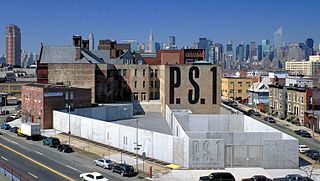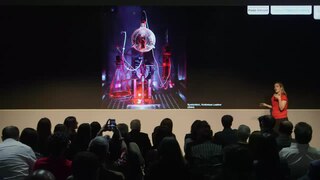
Philip Cortelyou Johnson was an American architect who designed modern and postmodern architecture. Among his best-known designs are his modernist Glass House in New Canaan, Connecticut; the postmodern 550 Madison Avenue in New York City, designed for AT&T; 190 South La Salle Street in Chicago; the Sculpture Garden of New York City's Museum of Modern Art; and the Pre-Columbian Pavilion at Dumbarton Oaks. His January 2005 obituary in The New York Times described his works as being "widely considered among the architectural masterpieces of the 20th century".

The Museum of Modern Art (MoMA) is an art museum located in Midtown Manhattan, New York City, on 53rd Street between Fifth and Sixth Avenues. The institution was conceived in 1929 by Abby Aldrich Rockefeller, Lillie P. Bliss, and Mary Quinn Sullivan. Initially located in the Heckscher Building on Fifth Avenue, it opened just days after the Wall Street Crash. The museum, America's first devoted exclusively to modern art, was led by A. Conger Goodyear as president and Abby Rockefeller as treasurer, with Alfred H. Barr Jr. as its first director. Under Barr's leadership, the museum's collection rapidly expanded, beginning with an inaugural exhibition of works by European modernists. Despite financial challenges, including opposition from John D. Rockefeller Jr., the museum moved to several temporary locations in its early years, and John D. Rockefeller Jr. eventually donated the land for its permanent site.

The International Style is a major architectural style and movement that began in western Europe in the 1920s and dominated modern architecture until the 1970s. It is defined by strict adherence to functional and utilitarian designs and construction methods, typically expressed through minimalism. The style is characterized by modular and rectilinear forms, flat surfaces devoid of ornamentation and decoration, open and airy interiors that blend with the exterior, and the use of glass, steel, and concrete.

MoMA PS1 is a contemporary art institution at 22-01 Jackson Avenue in the Long Island City neighborhood of Queens in New York City, United States. In addition to its exhibitions, the institution organizes the Sunday Sessions performance series, the Warm Up summer music series, and the Young Architects Program with the Museum of Modern Art. MoMA PS1 has been affiliated with the Museum of Modern Art since January 2000 and, as of 2013, attracts about 200,000 visitors a year.

Aino Maria Marsio-Aalto was a Finnish architect and a pioneer of Scandinavian design. She is known as the design partner of architect Alvar Aalto, with whom she worked for 25 years, and as a co-founder with him, Maire Gullichsen, and Nils-Gustav Hahl of the design company Artek, collaborating on many its most well-known designs. As Artek's first artistic director, her creative output spanned textiles, lamps, glassware, and buildings. Her work is in the permanent collection of the Museum of Modern Art (MoMA) in New York, and MoMA has included her work in nine exhibitions, the first of which was Aalto: Architecture and Furniture in 1938. Other major exhibitions were at the Barbican Art Gallery in London and Chelsea Space in London. Aino Aalto has been exhibited with Pablo Picasso.
Storefront for Art and Architecture is an independent, non-profit art and architecture organization located in SoHo, Manhattan in New York City. The organization is committed to the advancement of innovative positions in architecture, art and design.

Paola Antonelli is an Italian architect, curator, author, editor, and educator. Antonelli is the Senior Curator of Architecture and Design at the Museum of Modern Art (MoMA), New York, where she also serves as the founding Director of Research and Development. She has been described as "one of the 25 most incisive design visionaries in the world" by TIME magazine.

Neri Oxman is an Israeli-American designer and former professor known for art that combines design, biology, computing, and materials engineering. She coined the phrase "material ecology" to define her work.

Shofuso (Pine Breeze Villa), (Japanese: 松風荘) also known as Japanese House and Garden, is a traditional 17th century-style Japanese house and garden located in Philadelphia's West Fairmount Park on the site of the Centennial Exposition of 1876. Shofuso is a nonprofit historic site with over 30,000 visitors each year and is open to the public for visitation and group tours.

Alejandro Gastón Aravena Mori is a Chilean architect and executive director of the firm Elemental S.A. He won the Pritzker Architecture Prize in 2016, and was the director and curator of the 2016 Venice Biennale of Architecture.
Mario Gooden is an architect in the United States. He is the director at Mario Gooden Studio based in New York, New York. He was previously the principal of Huff + Gooden Architects which he co-founded with Ray Huff in 1997. Gooden is also a Professor of Practice and Director of the Master of Architecture program at the Graduate School of Architecture, Planning and Preservation (GSAPP) of Columbia University, where he teaches architectural design and theory. Gooden held previous academic appointments at the Yale School of Architecture as the Louis I. Khan Distinguished Visiting Professor, the Southern California Institute of Architecture (Sci-Arc) in Los Angeles, the University of Arizona (Tucson), the University of Florida (Gainesville), Clemson University, and The City College of New York.
Winka Dubbeldam is a Dutch architectural designer and academic. After her education in architectural design at Columbia University, she established her own firm, Archi-Tectonics, in 1994 in New York City. Her use of a combination of sustainable materials, innovative and inventive building methods with adoption of digital techniques has rewarded her with many accolades for her architectural projects. She has earned a reputation as a leading figure in modern architectural designs which has also made her "a real estate newsmaker". She is a Professor and Chair of architecture at the University of Pennsylvania. She is also the RIBA External Examiner for the Bartlett UCL London [2018-2022], the Creative Director for the Venice Biennale Virtual Italian Pavilion [2021]. Her Ted talk “Crowdfunding Urban Planning” was in TED Global in Edinburgh Scotland 2013.
Olalekan Jeyifous, commonly known as Lek, is a Nigerian-born visual artist based in Brooklyn, New York. He is currently a visiting lecturer at Cornell University, where he also received his Bachelor of Architecture in 2000. Trained as an architect, his career primarily focuses on public and commercial art. His work has been newly commissioned for the Reconstructions: Architecture and Blackness in America exhibition at the Museum of Modern Art in New York along with Amanda Williams, Walter Hood, and Mario Gooden. The exhibition explores the relationship between architecture and the spaces of African American and African diaspora communities and ways in which histories can be made visible and equity can be built.

Mabel O. Wilson is an American architect, designer, and scholar. She is the founder of Studio& and a professor at the Columbia University Graduate School of Architecture, Planning, and Preservation.
V. Mitch McEwen is an American architect and urban planner, cultural activist, and Assistant Professor at the Princeton University School of Architecture. She is co-founder of Atelier Office, a design and cultural practice working within the fields of urbanism, technology, and the arts. McEwen is a co-founder and member of the Black Reconstruction Collective and a board member of the Van Alen Institute in New York. She was given the 2010 New York State Council on the Arts Independent Projects Award for Architecture, Planning and Design.
Germane Barnes is an American architect, designer and an Assistant Professor of Architecture at the University of Miami in Florida. Barnes was a recipient of the 2021 Rome Prize in Architecture and the 2021 Wheelwright Prize.
Sean Canty is an American architect, cultural activist and academic. He is currently an Assistant Professor at the Harvard University Graduate School of Design, in Cambridge. Canty is co-Director of Office III, an experimental architectural collective, and founder of Studio Sean Canty based in Boston.
Sekou Cooke is an American-Jamaican architect, author and educator, and is associated with the style of Hip-hop architecture. He is the principal of Sekou Cooke Studio. Cooke is one of the founding members of the Black Reconstruction Collective.
J. Yolande Daniels is an American architect, designer and educator. She is a founding principal of studioSUMO, an architecture firm that speaks to socio-cultural landscapes through design.

Felecia Davis is an American architect, engineer and educator. She is principal of FELECIA DAVIS STUDIO where she bridges art, engineering, design and architecture. Davis is known for her work in computational textiles.











